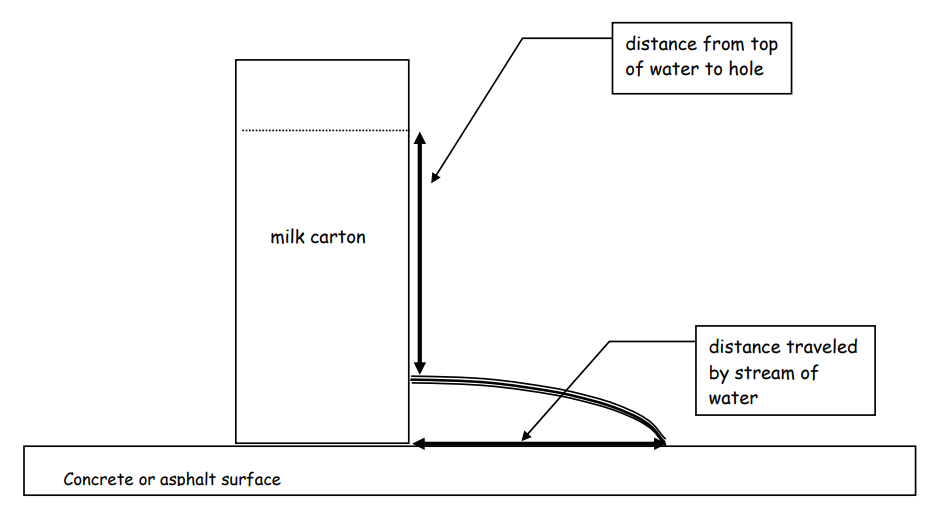Mathematics
Science
Grade Levels: 6th Grade, 7th Grade, 8th Grade, 9th Grade, 10th Grade, 11th Grade, 12th Grade,
Topics: AlgebraCoordinate SystemsLinear Equations and FunctionsPatternsFunctions and RelationsPhysical Science
Common Core State Standard: 5.G.1, 5.G.2, 6.EE.9, 7.RP.2a,
Knowledge and Skills:
Mathematics:
• Can plot a point in a two-dimensional coordinate system, given the coordinates, or determine the coordinates of a given point
• Can relate aspects of a graphical model to the real world situation which is being modeled
• Can determine the equation of a linear function that closely matches a set of points
Science:
• Understands the concept of “pressure.”
• Knows that pressure in a static fluid depends on depth.
(for each team)
• Clean and empty half gallon and quart milk containers
• Ruler
• A pen with a straight (rather than conical) tip, to be used for punching hole of a uniform size
Lesson:
Procedure: Prepare for presentation the Futures Channel movie, “Aquarium Makers.” Tell students that as they watch the movie, you want them to think about this question (which should be
posted):
What qualities or characteristics would you look for in the material that is used to make an aquarium?
At the end of the movie, discuss answers to the question, and when the answer “strength” comes up, ask why the material has to be strong. Elicit or present the concept of water pressure in response to this question, and review this concept to be sure it is understood as the force that water (or any fluid) exerts on the walls of the aquarium due to its weight. (To make this clear, ask students to consider whether or not aquarium walls would need to be strong in a zero-gravity or micro-gravity environment.)
Next, sketch two aquariums, as follows:

Ask students whether they think the water pressure at the bottom of these aquariums would be different and, if so, which would have the greater pressure and why. Discuss this for a few minutes, accepting all answers.
Tell students that they are going to investigate this question. Arrange them into teams of two or three members. Give half of the teams the quart milk carton, and the other half the halfgallon carton. Distribute the handout and make sure all teams understand the task before they begin. (Note: You may wish to discuss the variables, and which is independent and which is dependent, with the entire class before students begin the investigation.)
Step 8 would be done only with students who have studied the graphing of linear functions.
When all teams have finished, compare results for the different sizes of containers. You may also wish to replay the Movie and review what is said regarding thickness of aquarium walls
depending on the height of the aquarium.
Aquarium Under Pressure
Investigation
Instructions:
You will use a half gallon milk carton or quart milk container for this investigation.
1. Rinse out the container, and cut off the top. Use the tip of your pencil or pen to poke a small hole in it, about 3 inches from the bottom.
2. Arrange your experiment as shown in the diagram (outside, on the sidewalk or another flat surface).
3. Fill the container with water while keeping your finger over the hole. Measure the distance from the top of the water to the hole, and record it. Remove your finger to allow water to flow, and measure the distance the stream of water travels before it hits the surface.
4. After the water has dropped one inch, make both measurements again. Continue until there is not enough pressure to force the water into a stream as it comes out of the hole.
5. What are the variables of this experiment?
_______________________________________________________
6. Which is independent and which is dependent?
_______________________________________________________
7. Graph your data, and sketch a line or curve that smoothly connects the points on your graph.
8. Find an equation that creates a line which closely matches your data.

